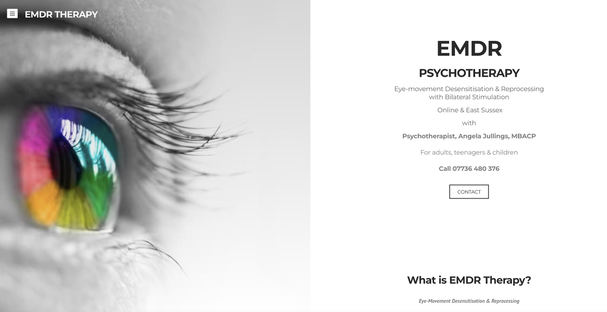EMDR Therapy & How It Can Help
|
What is EMDR Therapy and how does it work?
EMDR (eye movement desensitisation and reprocessing) is a clinical therapy which involves a series of rapid eye movements, like those of REM sleep, to reprocess disturbing memories, trauma or phobias and resolve and desensitise them emotionally. It can also involve a kinesthetic and auditory element to the process. It's an integrative psychotherapeutic tool used with adults and teenagers that has been researched extensively and is a proven aid for the treatment of trauma and many types of psychological stress. Using a rapid set of eye-movements, along with kinesthetic and auditory elements, whilst working with traumatic memories, feelings, bodily sensations and thoughts stimulates left and right brain integration so that trauma can be processed by the brain and body, just as in REM sleep. |
|
Trauma and its effects
We all experience traumatic experiences during our lives and we're often affected both emotionally as well as physically. Most of us will unconsciously heal the traumatic experience and move on from it. Some of us don't and the effects of such trauma can remain, leaving us with the affects of the experience and being vulnerable to re-triggering the emotional and physical responses to that trauma. Normally, when we sleep we naturally process our experiences from the day with REM sleep, where the eye movements connect right and left brain hemispheres. This brain activity whilst you sleep, although not understood fully, encourages resolution and understanding of situations within the unconscious mind. When we experience trauma and it doesn't get resolved or processed naturally due to overwhelm or being repeatedly subjected to trauma, the memory gets "frozen" in the hypothalamus brain. This may feel as raw or painful as its initial experience. The traumatic memory and its responses and emotions, stored in the neurology, unprocessed, in their raw form then get "triggered" afresh when similar situations, perceived similar situations or evoking experiences happen again. EMDR, used whilst the client is fully conscious and alert, reprocesses the memories, triggering desensitisation and resolution within the emotional self and the physical self, allowing the brain to heal any psychological disturbance whilst healing any physical affect of emotional trauma. What are the benefits of EMDR therapy? EMDR is an effective way to desensitise the images, sounds, emotions and bodily feelings associated with trauma. Studies consistently show that treatment with EMDR result in the healing of the targeted emotion(s) or somatic issues. The memory remains, although those too may seem different in your perception, and the negative emotions are neutralised, reduced or “flattened”. The emotional and physical "volume" of the emotion is lowered. The use of EMDR therapy has shown that the positive, long-term results affect all aspects of a client's well-being - the physical, mental and emotional. Because EMDR has the capacity to relieve many types of emotional block or fear, it is now used across a wide range of issues, making it possible to heal severe emotional trauma in a relatively short period of time. However, the length of therapy will vary according to the complexity of the issues being experienced by the individual. How can EMDR therapy help me? EMDR has been shown to help those who have developed psychological difficulties or disturbance originating from a traumatic experience such as an accident, violence, sexual abuse, childhood neglect, war zones, riots or terror attacks. The effects of such trauma often cause PTSD (post traumatic stress disorder.) What if I have little or no memory of the trauma? Angela often has clients who cannot recall specific memories. This is not an issue when working with EMDR. Instead, clients will sometimes have overwhelming or recurrent emotion or a somatic experience (where they "feel" the memory in their body but with no visual or auditory recollection of that memory). Angela works with these elements, as a visual, clear memory isn't necessary for EMDR work. |
What is PTSD?
PTSD, post-traumatic stress disorder, is classed as an anxiety disorder and can begin after witnessing or experiencing trauma. Trauma can be experienced as a life-threatening event and sometimes literally is, such as experiencing a terrorist attack or an accident. During trauma one may feel that we have no control over what is happening. After a traumatic experience you may feel confused, terrified or angry. It is when these feelings and sensations continue to be experienced or even worsen that PTSD can be diagnosed. Symptoms of PTSD may hinder your daily life and relationships. It's not known why some people who witness or experience such an event may develop PTSD and others not. PTSD has been known to change the body's response to stress. What is CPTSD (Complex PTSD)? Complex PTSD, known as CPTSD, is where a person has experienced repeated traumas, perhaps even differing types of trauma, rather than a one-off accident or traumatic incident. For example, where a child has been victim of domestic abuse or neglect over many years. How does PTSD or CPTSD develop? People who have had traumatic experiences don't necessarily develop PTSD but those with PTSD have all lived through a traumatic event(s) where they've seen or experienced disturbing situations and felt helpless and scared. Such strong and overwhelming emotional responses to the traumatic experience create changes in the brain and the body and the way it handles stress. Conditions treated with EMDR Studies shown to date have shown that EMDR therapy is highly effective with the following conditions: |




